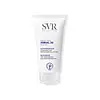What's inside
What's inside
 Key Ingredients
Key Ingredients

 Benefits
Benefits

 Concerns
Concerns

 Ingredients Side-by-side
Ingredients Side-by-side

Water
Skin ConditioningUrea
BufferingGlycerin
HumectantCetearyl Alcohol
EmollientCaprylic/Capric Triglyceride
MaskingGlyceryl Stearate
EmollientEthylhexyl Cocoate
EmollientHydrogenated Coco-Glycerides
EmollientOctyldodecanol
EmollientSodium Lactate
BufferingGlyceryl Stearate Se
EmulsifyingDistarch Phosphate
AbsorbentCeramide NP
Skin ConditioningLactic Acid
BufferingArginine Hcl
Skin ConditioningSodium PCA
HumectantCholesterol
EmollientHelianthus Annuus Seed Oil
EmollientAlanine
MaskingCarnitine
CleansingGlycine
BufferingSodium Chloride
MaskingDimethicone
EmollientCarbomer
Emulsion StabilisingSorbitan Stearate
EmulsifyingSodium Cetearyl Sulfate
CleansingPhenoxyethanol
PreservativeWater, Urea, Glycerin, Cetearyl Alcohol, Caprylic/Capric Triglyceride, Glyceryl Stearate, Ethylhexyl Cocoate, Hydrogenated Coco-Glycerides, Octyldodecanol, Sodium Lactate, Glyceryl Stearate Se, Distarch Phosphate, Ceramide NP, Lactic Acid, Arginine Hcl, Sodium PCA, Cholesterol, Helianthus Annuus Seed Oil, Alanine, Carnitine, Glycine, Sodium Chloride, Dimethicone, Carbomer, Sorbitan Stearate, Sodium Cetearyl Sulfate, Phenoxyethanol
Water
Skin ConditioningUrea
BufferingGlycerin
HumectantButyrospermum Parkii Butter
Skin ConditioningOctyldodecanol
EmollientCetearyl Ethylhexanoate
EmollientIsohexadecane
EmollientPolyacrylate-13
Silica Dimethyl Silylate
EmollientTriethanolamine
BufferingPanthenol
Skin ConditioningSalicylic Acid
MaskingSerine
MaskingAllantoin
Skin ConditioningBacillus Ferment
Skin ConditioningHistidine
HumectantPolyisobutene
Octyldodecyl Xyloside
EmulsifyingPEG-30 Dipolyhydroxystearate
EmulsifyingPolysorbate 20
EmulsifyingSorbitan Isostearate
EmulsifyingPropylene Glycol
HumectantCitric Acid
BufferingDisodium EDTA
Potassium Sorbate
PreservativeWater, Urea, Glycerin, Butyrospermum Parkii Butter, Octyldodecanol, Cetearyl Ethylhexanoate, Isohexadecane, Polyacrylate-13, Silica Dimethyl Silylate, Triethanolamine, Panthenol, Salicylic Acid, Serine, Allantoin, Bacillus Ferment, Histidine, Polyisobutene, Octyldodecyl Xyloside, PEG-30 Dipolyhydroxystearate, Polysorbate 20, Sorbitan Isostearate, Propylene Glycol, Citric Acid, Disodium EDTA, Potassium Sorbate
Alternatives
Ingredients Explained
These ingredients are found in both products.
Ingredients higher up in an ingredient list are typically present in a larger amount.
Glycerin is already naturally found in your skin. It helps moisturize and protect your skin.
A study from 2016 found glycerin to be more effective as a humectant than AHAs and hyaluronic acid.
As a humectant, it helps the skin stay hydrated by pulling moisture to your skin. The low molecular weight of glycerin allows it to pull moisture into the deeper layers of your skin.
Hydrated skin improves your skin barrier; Your skin barrier helps protect against irritants and bacteria.
Glycerin has also been found to have antimicrobial and antiviral properties. Due to these properties, glycerin is often used in wound and burn treatments.
In cosmetics, glycerin is usually derived from plants such as soybean or palm. However, it can also be sourced from animals, such as tallow or animal fat.
This ingredient is organic, colorless, odorless, and non-toxic.
Glycerin is the name for this ingredient in American English. British English uses Glycerol/Glycerine.
Learn more about GlycerinOctyldodecanol is a fatty alcohol. It is primarily used to enhance the texture of products.
As an emulsifier, Octyldodecanol helps prevent the oils and waters from separating. It also prevents ingredients from creating foam when shaken.
Octyldodecanol is created by reducing fatty acid to an alcohol.
Due to its high molecular weight, it does not get absorbed into the skin.
Learn more about OctyldodecanolUrea is also called carbamide and is the diamide of carbonic acid. In cosmetics, urea is used to hydrate the skin. It also provides exfoliation in higher concentrations.
As a humectant, urea helps draw moisture from the air and from deep within the skin. This helps hydrate your skin. Studies show urea is an effective moisturizer for dry skin conditions. 40% urea is typical in medications for treating eczema and other skin conditions.
Urea has the strongest exfoliation effect in concentrations higher than 10%. It is a keratolytic agent, meaning it breaks down the keratin protein in the top layer of skin. This helps remove dead skin cells and flaking skin.
In medicine, urea has been shown to help increase the potency of other ingredients, such as fungal treatments.
Humans and animals use urea to metabolize nitrogen-containing compounds. Urea is highly soluble in water. Once dissolved, it is neither acidic nor alkaline.
Learn more about UreaWater. It's the most common cosmetic ingredient of all. You'll usually see it at the top of ingredient lists, meaning that it makes up the largest part of the product.
So why is it so popular? Water most often acts as a solvent - this means that it helps dissolve other ingredients into the formulation.
You'll also recognize water as that liquid we all need to stay alive. If you see this, drink a glass of water. Stay hydrated!
Learn more about Water